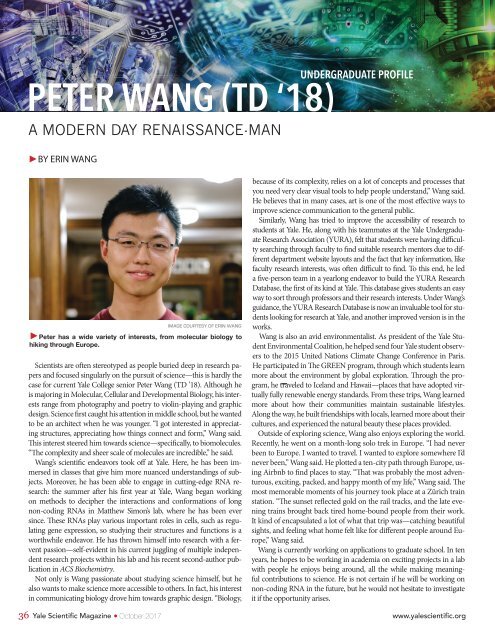YSM Issue 90.4
Create successful ePaper yourself
Turn your PDF publications into a flip-book with our unique Google optimized e-Paper software.
PETER WANG (TD ‘18)<br />
A MODERN DAY RENAISSANCE-MAN<br />
►BY ERIN WANG<br />
UNDERGRADUATE PROFILE<br />
IMAGE COURTESY OF ERIN WANG<br />
►Peter has a wide variety of interests, from molecular biology to<br />
hiking through Europe.<br />
Scientists are often stereotyped as people buried deep in research papers<br />
and focused singularly on the pursuit of science—this is hardly the<br />
case for current Yale College senior Peter Wang (TD ’18). Although he<br />
is majoring in Molecular, Cellular and Developmental Biology, his interests<br />
range from photography and poetry to violin-playing and graphic<br />
design. Science first caught his attention in middle school, but he wanted<br />
to be an architect when he was younger. “I got interested in appreciating<br />
structures, appreciating how things connect and form,” Wang said.<br />
This interest steered him towards science—specifically, to biomolecules.<br />
“The complexity and sheer scale of molecules are incredible,” he said.<br />
Wang’s scientific endeavors took off at Yale. Here, he has been immersed<br />
in classes that give him more nuanced understandings of subjects.<br />
Moreover, he has been able to engage in cutting-edge RNA research:<br />
the summer after his first year at Yale, Wang began working<br />
on methods to decipher the interactions and conformations of long<br />
non-coding RNAs in Matthew Simon’s lab, where he has been ever<br />
since. These RNAs play various important roles in cells, such as regulating<br />
gene expression, so studying their structures and functions is a<br />
worthwhile endeavor. He has thrown himself into research with a fervent<br />
passion—self-evident in his current juggling of multiple independent<br />
research projects within his lab and his recent second-author publication<br />
in ACS Biochemistry.<br />
Not only is Wang passionate about studying science himself, but he<br />
also wants to make science more accessible to others. In fact, his interest<br />
in communicating biology drove him towards graphic design. “Biology,<br />
because of its complexity, relies on a lot of concepts and processes that<br />
you need very clear visual tools to help people understand,” Wang said.<br />
He believes that in many cases, art is one of the most effective ways to<br />
improve science communication to the general public.<br />
Similarly, Wang has tried to improve the accessibility of research to<br />
students at Yale. He, along with his teammates at the Yale Undergraduate<br />
Research Association (YURA), felt that students were having difficulty<br />
searching through faculty to find suitable research mentors due to different<br />
department website layouts and the fact that key information, like<br />
faculty research interests, was often difficult to find. To this end, he led<br />
a five-person team in a yearlong endeavor to build the YURA Research<br />
Database, the first of its kind at Yale. This database gives students an easy<br />
way to sort through professors and their research interests. Under Wang’s<br />
guidance, the YURA Research Database is now an invaluable tool for students<br />
looking for research at Yale, and another improved version is in the<br />
works.<br />
Wang is also an avid environmentalist. As president of the Yale Student<br />
Environmental Coalition, he helped send four Yale student observers<br />
to the 2015 United Nations Climate Change Conference in Paris.<br />
He participated in The GREEN program, through which students learn<br />
more about the environment by global exploration. Through the program,<br />
he traveled to Iceland and Hawaii—places that have adopted virtually<br />
fully renewable energy standards. From these trips, Wang learned<br />
more about how their communities maintain sustainable lifestyles.<br />
Along the way, he built friendships with locals, learned more about their<br />
cultures, and experienced the natural beauty these places provided.<br />
Outside of exploring science, Wang also enjoys exploring the world.<br />
Recently, he went on a month-long solo trek in Europe. “I had never<br />
been to Europe. I wanted to travel. I wanted to explore somewhere I’d<br />
never been,” Wang said. He plotted a ten-city path through Europe, using<br />
Airbnb to find places to stay. “That was probably the most adventurous,<br />
exciting, packed, and happy month of my life,” Wang said. The<br />
most memorable moments of his journey took place at a Zürich train<br />
station. “The sunset reflected gold on the rail tracks, and the late evening<br />
trains brought back tired home-bound people from their work.<br />
It kind of encapsulated a lot of what that trip was—catching beautiful<br />
sights, and feeling what home felt like for different people around Europe,”<br />
Wang said.<br />
Wang is currently working on applications to graduate school. In ten<br />
years, he hopes to be working in academia on exciting projects in a lab<br />
with people he enjoys being around, all the while making meaningful<br />
contributions to science. He is not certain if he will be working on<br />
non-coding RNA in the future, but he would not hesitate to investigate<br />
it if the opportunity arises.<br />
36 Yale Scientific Magazine October 2017 www.yalescientific.org


















